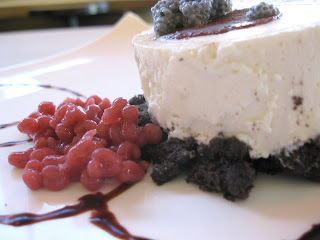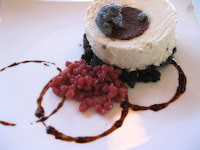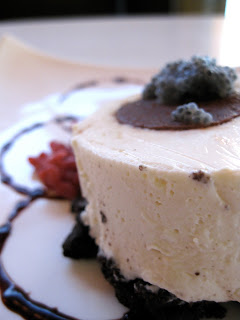
For the restaurant industry, there is always a lull in business between New Years and the beginning of spring. It’s the time where you see most restaurants tightening their belts, cutting labor costs, and spending less wherever possible. It’s also the time when many restaurants go under. Between the normal expenditures and taxes that are due, even diligent owners can find themselves with the painful realization that their product isn’t selling.
Valentines Day, our favorite Hallmark holiday, is highly anticipated in the restaurant community, because it is a night where one can be certain that the numbers will be good. While it doesn’t do a whole lot in the long run for a restaurants financials, it does provide much-needed morale to employees who are generally bored. Finally, we get to make something different. Finally we get to serve something exciting. At least, that’s the theory…
If there’s something that I’ve discovered in researching for this particular dessert, it’s that people tend to play it safe on v-day. Whether they know it or not, I think people tend to stick to things that they are certain are going to taste good. No matter how good the apples look right now, no matter how extravagant the preparation, it won’t sell. Customers look to the night’s dessert with only one real question: is it chocolate?
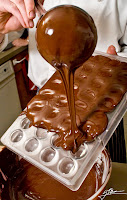
Chocolate’s power as an aphrodisiac is debatable at best, but I can’t deny that it satisfies something deep in the soul. Like wine, where you get your chocolate from will greatly affect its flavor. The climate, or terrior as wine aficionados would call it, and how the beans are roasted give an unimaginable range of flavors: from smokey and bitter, or tart and fruity, to sweet with hints of caramel.
I could go on at length about chocolate production, but I think I’ll save that for another post. Books and books have been written on the subject, and there’s still more out there yet to be uncovered. For the moment, I think I will just give you a couple of my thoughts on choosing and eating chocolate:

· Know what you’re buying. Chocolate is expensive. Good chocolate should be [relatively] expensive. Spending money on Hershey’s is like buying non-alcoholic Keystone Light. It’s just not worth it. I’m not saying that you should be unloading your next paycheck for one bar, but go out on a limb and reach for the upper shelf occasionally.
· Don’t count out milk and white chocolate. Many adults claim that milk and white chocolate are for kids who’s taste buds haven’t’ developed yet. Shut up. Anyone who’s had a great milk chocolate can tell you that it is a life-changing experience. A good milk chocolate should let you taste the cocoa bean as much as a dark should.
· Take the percentages that chocolate maker’s proudly display with a grain of salt. They can be very misleading, and are not the mark of what makes chocolate great. All that little number means is how much of that bar is cacao, and how much is not. Two chocolates that are labeled as 64% can taste vastly different. The only time a use those is as a way to differentiate between chocolates that one company makes, since they are rarely given other names.
· Some brands I tend to like: Voges, Sharffen berger, El Rey, Valrhona (though it’s given more credit than it is due), and Callebaut
· Some brands I tend to stay away from: Hershey’s, Lindt, Ghiradelli
These are, of course, my own opinion. I’m not going to come to your house and throw out all of the bad chocolate. In fact, I’m sure I have stashed away somewhere a couple Hershey’s bars from my last camping trip. Does that make me a hypocrite? Probably. Depends on whom you talk to.
As for the much-anticipated Valentines dessert, I decided to stick with something that most people could identify with. I took my inspiration from a hazelnut laté, and deconstructed it.

For the coffee part, I made an espresso semifreddo. Semifreddo literally means “half frozen,” but it really refers to a frozen mousse, of sorts, that has had so much air incorporated into it prior to freezing that it never gets completely solid. I simply whipped my espresso infused cream, whipped my egg yolks, and whipped my egg whites and gently folded them all together depositing into a flexipan and freezing.
For the first chocolate component of the plate, I made a pudding cake. Pudding cake, like French toast, is a great way to use up a product that would otherwise be thrown away. I had some leftover chocolate almond cake from a previous dessert. They were odd shaped pieces, some of which had dried out, but still tasted wonderful. To make the pudding cake, I made a custard of egg yolks, cream, sugar and chocolate, and then added the leftover cake, mixing until the pieces had broken up into a homogenous mass. They were then baked and allowed to cool in the freezer before cutting into little rectangles. They would be warmed to order, which would contrast nicely with the cold semifreddo.

The hazelnut component was the chocolate-hazelnut gelato that I froze into little cylinders. I topped the semifreddo with a toasted marshmallow at the behest of my girlfriend—who was kind enough to not be mad at me when I had to spend v-day with the restaurant instead of her, and finished the plate with some cocoa nib lace that provided the much-needed crunch.
I don’t have any recipes this week, but I do have some promising ideas.

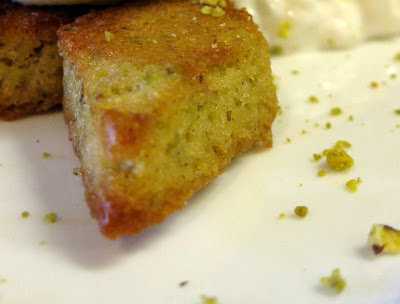
 What would go with pistachio financiers? Well, anything. In fact, it was only sheer willpower that kept me from eating the entire batch. Of course, they would be delicious with a cup of tea, such as Earl Grey, or English Breakfast. They also would be good dipped in chocolate or served with preserves. For me, I used them to sop up the remnants of a tasty coconut rice pudding with a scoop of banana-pineapple sorbet.
What would go with pistachio financiers? Well, anything. In fact, it was only sheer willpower that kept me from eating the entire batch. Of course, they would be delicious with a cup of tea, such as Earl Grey, or English Breakfast. They also would be good dipped in chocolate or served with preserves. For me, I used them to sop up the remnants of a tasty coconut rice pudding with a scoop of banana-pineapple sorbet.